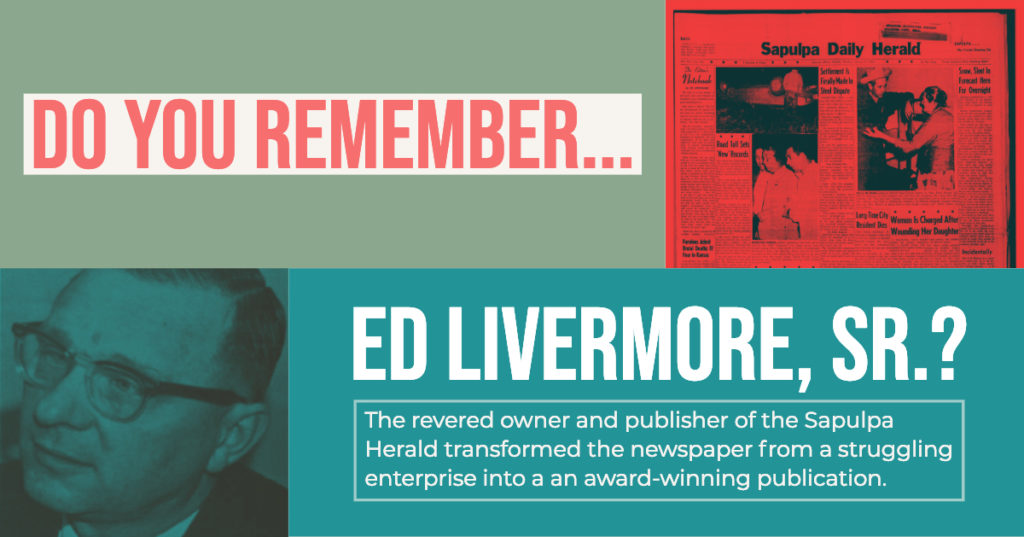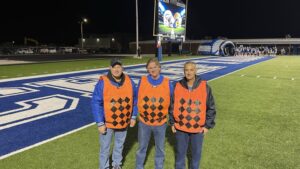The newspaper business was in Ed Livermore’s blood. At the young age of ten, while working as a “printer’s devil,” Edward Knowles Livermore decided he wanted to be in the newspaper business.
After graduating from high school in 1936, Mr. Livermore attended OU’s School of Journalism where he met Melba Hudson. Both were advertising majors. Ed Livermore graduated from OU in 1940 and was married in 1941. Livermore went to work for the Anadarko Daily News as an advertising salesman. After serving in the Army during WWII, he returned to work on the Anadarko paper.
In 1947, Ed Livermore and his wife, Melba, bought into the Claremore Weekly Progress. The Livermores and their partners turned it into a daily paper. Subsequently, they became equal partners with Wheeler Mayo. Ed Livermore became general manager and was responsible for the editorial page. In 1975, Livermore bought out Wheeler Mayo and became the sole owner of the Claremore Progress.
Ed Livermore firmly believed that extensive local news coverage was essential to a local newspaper. Livermore made sure they “covered the waterfront.” He wrote a daily editorial column that was extremely popular and won many awards. This formula worked quite well for the newspaper, as the circulation tripled by 1957. In 1959, Ed and Melba Livermore purchased the Sapulpa Herald from R.P. Matthews for $135,000. Livermore began immediately upgrading the antiquated press and shop equipment.
Livermore employed his same policy of aggressive local coverage that had worked well in Claremore. Livermore discovered that under the Matthews, the Sapulpa Herald did not cover many meetings and all the public records were being ignored. Under Livermore’s management, the Herald began covering all city council meetings, county commissioner meetings, and school board meetings. The paper began reporting all local public records, and anything that happened in Sapulpa.
His policies paid off and circulation started climbing. When asked about the Tulsa newspapers’ coverage of Sapulpa, Livermore said, “We covered the same things, but we just did a better job of it.”
Livermore also owned KXOJ radio station for several years, selling it in the late 1970s. He also had an interest in a cable television company. Through the years, Ed and Melba Livermore acquired many holdings, including the Edmond Evening Sun, the Guthrie Leader, several weekly publications, and newspapers in Texas and Arkansas.
Ed Livermore sold the Sapulpa Herald in 1979, to Roy Park, owner of the Park Newspapers chain. There was a non-disclosure clause involving the sale price but several sources say the sale brought Livermore more than $5 million. At the time of the sale, in 1979, under the Livermores’ ownership, the circulation of the Sapulpa Herald soared to 9,000, which was half the population of Sapulpa. It was also, at that time, considered to be the best equipped, small offset daily newspaper in the State of Oklahoma. During that period, the Livermores transformed the Sapulpa Herald from a poorly equipped, struggling enterprise, into a state and nationally-awarded newspaper.
Ed Livermore was an icon of the newspaper business. He truly became a legend in the annals of newspaper journalism. He was a board member and President of the National Newspaper Association, receiving its highest honor, the Amos Award. He was President of the Oklahoma Press Association and United Press Editors of Oklahoma. He won many state and national awards for his editorials. Ed Livermore was inducted into the Oklahoman Newspaper Hall of Fame in 1970.
I interviewed Chuck Lake, who worked for Ed at the Sapulpa Herald for twenty years. I asked him for his thoughts on Mr. Livermore. Chuck said Ed Livermore was “hard-working, strong, and a community builder.” Livermore founded the Creek County Industrial Authority and at one time was President of the Sapulpa Chamber of Commerce.
Chuck Lake started working for the Sapulpa Herald when R.P. Matthews owned it. The first year that Chuck worked for Ed Livermore was not that enjoyable. Working for the former publisher was a “softer routine,” and it was a matter of “getting ‘re-acclimated’ to a new publisher. I will tell you where things really changed. I got kinda ticked off at him one time, and I made up my mind that he could not get up early enough in the morning to get ahead of me. When I adopted that attitude, he and I became nearly kin.”
One thing that impressed Lake was that Livermore strived for journalistic honesty and accuracy. He said if it was “a sensitive story,” Livermore wanted at least two sources to confirm the story. Lake thought as far as dedicated journalists go, Ed Livermore “was absolutely one of the best.”
What I remember most about Ed Livermore was that he strongly believed that the local newspaper should be the eyes and ears of the citizenry, keeping a watchful eye on local government. His editorials were always spot on and my mother thought he was a guardian of the truth.
I was in his home several years ago servicing a piece of electronic equipment. I had a rather long talk with him and found him to be extremely intelligent, well-versed on current affairs and a gracious and humble person. Something that impressed me was that he kept the letters to the editor that were sent to him. He walked over to a file cabinet, pulled out a letter and handed it to me. He said, “This is a letter your mother wrote to me in 1961. I thought you might like to have it.” I thought that was a lovely gesture.
Even after his sale of the Sapulpa Herald, Mr. Livermore stayed involved in the community and was a strident community activist, striving to make Sapulpa a better place to live. Ed Livermore passed away in 2014, but his remarkable legacy lives on.











